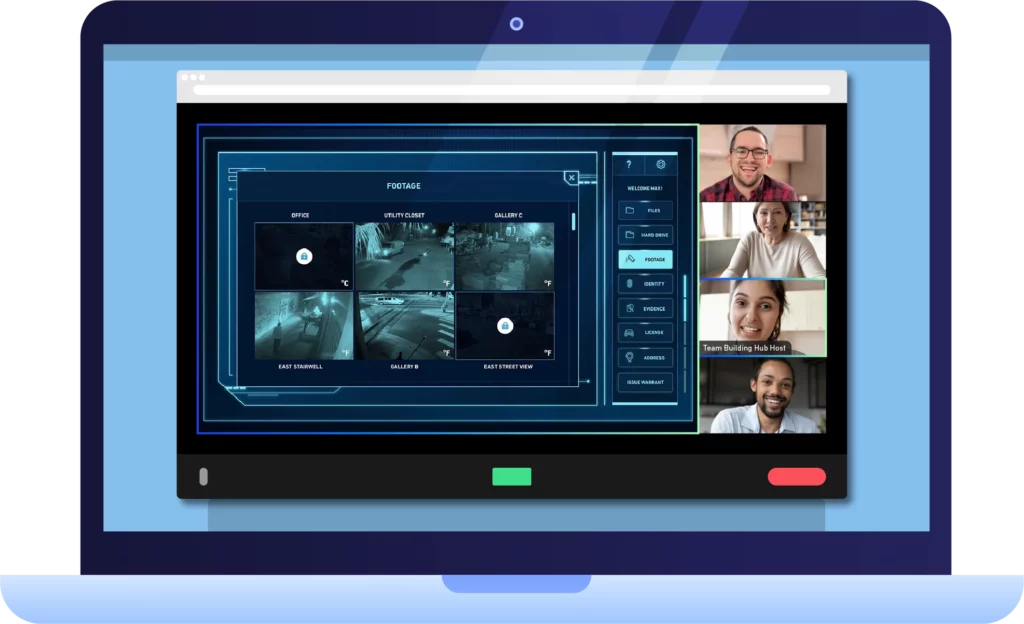Having a standardized and effective employee training protocol is essential for any business. Not only do employees need to get up to speed on your company’s current processes, but every industry changes over time due to economic, technological, or societal shifts. Training can keep your company and your people up-to-date and competitive. But there’s a lot to consider when thinking through your employee training program. Keep reading for more information about employee training and what you’ll need to consider when building an engaging program.
Table of Contents
Your Guide to Developing an Employee Training Program
What is Employee Training?
Regardless of your company’s industry, you’ll need a robust employee training plan. Employee training refers to a program designed to help your people learn and improve skills or knowledge for their current role. This might mean training your employees to perform a job more efficiently, successfully, or even safely. Employee training can take various forms and happen through different delivery mechanisms.
The details of your training program will ultimately be unique to your company. But most companies will benefit from incorporating the common types of employee training.
Six Common Types of Employee Training
1. Orientation
Orientation training involves educating employees about the company, its structure, leadership team, mission, vision, and values. New employees are also completing paperwork and getting a tour of the inner workings of your business.
2. Onboarding
Onboarding can encompass orientation training and also include more role-specific training. This is where you explain to employees how their role fits within the team, how the team supports the function and how the function or department supports the organization overall.
3. Technical Skills
Whether employees are new or veterans of your company, there’s always room to level up technical skills! Technical skills can refer to things like writing, data analysis, coding, and more. These are the industry- and company-specific skills that folks will need to be productive.
4. Soft Skills
Behaviors, attitudes, habits, and interpersonal skills play a role in how your teams work together. To understand soft skills, think about who people are and how they relate to others rather than what they can do. For example, you can train employees on problem-solving, communication, and resilience. You’ll want to encourage your employees to develop the soft skills that create high-functioning teams who relate well to one another.
5. Products or Services
This training ensures employees represent the business accurately, trains them on the products and services you offer, how you go to market, and who your core customers are.
6. Compliance
Industries like manufacturing, healthcare, finance, or transportation are highly regulated and need to follow strict laws. Compliance training educates employees about any legal obligations they need to follow. Without compliance training, you open the door to a host of liability risks.
Remember: no matter what employee training you do, you’ll need to ensure employees are engaged throughout the process.

What is the Difference Between Employee Training and Employee Development?
You’ll often hear employee training and development used together or interchangeably. While similar, employee development refers more broadly to the overall process your company outlines to help employees gradually upskill and acquire new knowledge. In other words, employee development encompasses employee training but is more expansive and includes future performance, rather than just the execution of a current job or role.
Why is Employee Training Important?
Every company should invest in employee training — it’s critical to stay competitive in every industry and provides a host of benefits. By teaching your people various skills, you’ll fill gaps, retain more people, and boost morale across your organization.
Addresses Performance and Knowledge Gaps
Company needs will evolve as the industry and the competitive landscape evolves. That means that the skillsets you need to succeed might shift over time. Training your employees allows you to fill those gaps without the time and expense of hiring new people.
Lowers Employee Turnover
A company that trains its employees, retains its employees. Employee training ensures your folks know how to perform their jobs to the best of their ability. No one enjoys feeling unprepared or undertrained for a role. Training promotes clarity around what success looks like so employees know when they’re hitting the mark.
Improves Employee Morale
When companies invest in excellent employee training, employees feel valued and understand that the company is interested in setting them up for success.

How Much Do Companies Spend on Employee Training?
One study found that firms that spend an average of $1,595 per employee for training experienced 24% higher gross profit margins. Not only does employee training help increase revenue, but it’s also less expensive than hiring new talent.
Determining how much to spend on your employee training will depend heavily on your company’s industry, size, and financial health.
Here’s some of what we know from the 2021 Training Industry Report:
- On average, companies spent $1,071 per learner in 2021, compared with $1,111 per learner in 2020
- Government and military organizations spent $1,483 per learner
- Manufacturers/distributors spent $1,373 per learner
- Large companies (10,000+ employees) spent $722 per learner
- Midsize companies (1,000 to 9,999 employees) spent $902 per learner
- Small companies (100 to 999 employees) spent $1,433 per learner
While the specifically recommended spend might be debatable, investing in employee training is not. The most important thing to do when it comes to employee training is to start now and start where you can!
What Makes Employee Training Successful?
Success is the accomplishment of an aim or purpose. By extension, successful employee training will achieve what the training sets out to do. Broadly speaking, employee training should aim to:
- Improve the business in a measurable way (revenue, safety, efficiency, etc.)
- Teach employees a new skill
- Teach employees new information
- Help employees complete a process more efficiently or safely
- Engage and excite employees throughout the process
If your training accomplishes one (or ideally all) of the above, you’re on the right track! Keep reading for more about how to accomplish each of these goals by thinking through and applying the strategies below.

Your Guide to Developing an Employee Training Program
As you look to implement an employee training program, keep these strategies and tips in mind. Once your program is finalized, you’ll need to make it clear what’s required and ensure it’s easy to access for all employees.
1. Consider Your Business Needs, KPIs, and Industry
The needs of your business, key performance indicators (KPIs), and industry should inform your employee training program. After all, employee training that doesn’t contribute to the success of the business is pointless — and employees like to know how additional training impacts the business overall!
So before you start developing your training plan, take time to understand the needs of your business, your industry, and any key performance indicators that gauge long-term performance.
Business Needs
Business needs are the gaps between the current state of your company and its goals. In other words, you can think of business needs as the current goals or opportunities for improvement. Once you better understand and outline your business needs, you’ll better understand how your employees can help fill those gaps.
Key Performance Indicators (KPIs)
KPIs are the quantifiable measurements used to gauge your company’s long-term performance. KPIs might be financial (i.e., revenue targets), customer-focused (i.e., satisfaction and retention) or even process-related (operational performance).
For example, your company might need to meet a particular revenue target — that means your sales team needs to meet a certain quota to hit that goal. From there you can conduct an analysis about whether all your salespeople are on track to meeting the goal and consider if an investment in additional sales training is needed.
Industry
Your industry might play a key role in the kinds of training you should offer to meet your business needs or stay competitive. Take a step back and look at the current trends in your field. Are your competitors moving towards new software solutions? This might indicate that your company needs to adopt a similar model and your team needs to be trained to use new software.
Be sure to consider any relevant industry benchmarks. For example, if your safety numbers are lower than the average across the industry, it might be time to address the problem through increased safety training and support for employees.
2. Outline the Learning Objectives
Once you understand the gaps that employee training can address, it’s time to solidify and articulate them as learning objectives for each training. What are the desired learning outcomes of the training? In just a couple of sentences, you’ll want to clearly outline what you intend for employees to learn throughout the program.
Here are some things to keep in mind when creating learning objectives:
- Keep it short: Learning objectives should be just a sentence or two long.
- Keep it simple: Use simple, easy-to-understand language to promote clarity and understanding.
- Keep it specific: Avoid any sweeping statements like “improve safety.” There’s a lot involved in improving safety. On the other hand, “Employees will be able to identify and address common unsafe workplace habits,” is a more descriptive and measurable objective.
- Keep it clear: Choose your verbs carefully. Is the objective really for employees to “understand” the concept? Or is it for them to “apply” the concept? Verb choice matters!
- Keep it realistic: Don’t try to boil the ocean. Ensure that the learning objective is feasible and can be accomplished through that specific training.
- Keep it measurable: By setting measurable goals from the outset, later you can evaluate whether employees achieved what they set out to learn.
Sample learning objectives:
- After completing this training, employees will be able to correctly set up their profile in the sales tracking system.
- After completing this course, employees will be able to operate the cash register to complete a sale.
- Following this training, employees will be able to identify and correct the top five safety mistakes on the manufacturing line.

3. Develop the Learning Journey
When thinking through your employee training program, consider the overall learning journey. The learning journey refers to the series of learning experiences that happens over time and is a blend of formal and informal interventions and touchpoints. You’ll want to consider the order in which employees learn certain skills, how they build on one another and how you’ll reinforce the learning beyond training.
Learning journeys, especially when shared with employees, promote continuous learning within an organization. This emphasizes that learning and training are never one-and-done, but rather a process that always involves learning new skills and acquiring more knowledge while employed at your company.
A new employee’s learning journey might start with awareness of the company values and ways of working, and over time include managerial training and other soft skills.
Use the Employee Lifecycle
The employee lifecycle can be a helpful tool for planning and thinking through the different moments in an employee’s training and development at your company.
What might they need to know before day one? Or during onboarding? Or after 90 days? Outlining these key moments from the outset will help as you make plans to roll out training.
Incorporate Competencies
Be sure to also consider the career paths for various roles within the organization. What skills do employees need to move to the next level? How are you training them to develop those skills? If a promotion will involve additional responsibilities or skill sets, chart out the journey employees need to embark on to qualify for a new role.

4. Select Your Training Styles
Training can take various forms. Depending on the material being taught and various organizational dynamics, you’ll want to mix and match and choose the style best suited for your people and training content.
eLearning or Technology-Based Learning
Also, known as online or virtual training, eLearning is quickly becoming one of the most popular training styles. Employees can learn at their own pace and often benefit from the various interactive features (quizzes, games, etc.) that virtual learning can offer. It’s also scalable and easily deployed to most people.
eLearning can be outsourced to companies that partner with businesses. For example, the Udemy Business platform offers more than 16,000 courses in 14 languages. Courses include everything from tech and business skills to leadership and managerial training, all with world-class instructors.
However, eLearning can provide some challenges. For example, designing the training software and instructional material is often time-consuming and can require frequent updates. Furthermore, a heavy reliance on video content for lessons can be draining for employees to sit through and time-consuming to re-edit and update.
Instructor-led
Instructor-led training is one of the most traditional forms of training. Employees can ask questions and engage with someone who understands the nuances of the content. Instructors are also able to facilitate discussions that can deepen understanding and can create more friendly environments by using fun icebreakers that get conversation flowing from the start.
But instructor-led training is also time-consuming and doesn’t allow employees to move at their own pace. And with the rise in remote work and more employees located across multiple time zones, it can be inconvenient to schedule.
Unlike eLearning or technology-based training, instructor-led training can be hard to scale. As class sizes increase, each employee’s access to the instructor decreases, which can impact learning.
Simulation
Certain skills, like flying a plane or operating complex machinery, benefit from simulation-based training. Simulation training mimics the work environment and allows employees to practice in near-real situations, often under similar levels of pressure. But as with all training styles, simulation has its drawbacks, namely cost and the inability to fully mimic real-life conditions.
Group discussions
Group training fosters social interactions that can lead to a deeper understanding of the learning material. The conversation and feedback among peers increase the learning opportunities. These types of training can be instructor-led or directed through online prompts. Group training is often more cost and time effective.
On-the-Job or Hands-on Training
This training style tosses employees straight into the work environment to learn through practice in real-life scenarios. This style is useful as it promotes learning through doing, which is often easier to grasp than theory through videos or lectures. Employees who do on-the-job training often benefit from shadowing another employee for a period of time to get more comfortable before diving right in.

5. Incorporate Adult Learning Principles
Part of designing an engaging learning experience for employees means incorporating adult learning principles. Adults have different learning styles – make the most of that!
Malcolm Knowles, an American educator, is often credited with popularizing the term andragogy as synonymous with adult education or learning.
When training employees, the goal is to keep them motivated and engaged throughout the process. To do that, you’ll need to understand how adults view learning.
Here’s what we can glean from Knowles:
Adults have a mature self-concept.
Self-concept matures from a dependent personality toward being a self-directed human being. Therefore, adults learn best and feel most empowered when involved in the planning and evaluation of their instruction.
Adults like to use experience as a teacher.
As people grow, they accumulate a breadth and depth of experience that becomes an increasing resource for our learning. You can use life experiences, both successes and failures as the foundation of learning activities.
Adults want to know they’re learning relevant information.
An adult’s readiness to learn is directly tied to understanding the “why.” As people get older, they want to understand “what’s in it for me?” How does this help me do something professionally or personally?
Adults like to solve problems.
Children primarily learn information that they’re told will be useful one day. Adults, on the other hand, prefer information that’s immediately useful. To motivate your employees, help them understand what problem or issue the learning tackles. When they understand the problem to be solved, they get engaged in learning the solution.
Adults need to be self-motivated.
Kids have parents and teachers to force them. Adults need internal motivators to push them. Think through how your business can build internal motivation. Does this put employees on the path to a promotion? The drive to reach a new level is a great example of an internal motivator.
6. Evaluate and Measure
The hardest part is getting the training off the ground. Once you do, you’ll need to evaluate and measure for effectiveness. You want to do two things: test employees’ retention of the material and solicit feedback about the way the training was conducted.
While employee understanding and information/skill retention is the primary goal of training, you’ll have an easier time getting folks to participate if it’s fun and engaging! Solicit feedback from employees to understand what they thought worked well and the opportunities for improvement. You can do this through a quick survey following the training.
Armed with that information, you’ll be able to make the necessary updates to the training program that keeps employees excited to come back for more.

Training Employees to Work as a Team
Team building is an often-overlooked area of employee training. Mastering the ability to work together is arguably as important as learning role-specific skills and knowledge. Training teams to work together allows employees to forge connections that translate to smoother, healthier working relationships.
Try these creative ways to train your team to work together:
- Plan a virtual scavenger hunt! By collaborating as a team to accomplish a common goal, employees learn valuable lessons about partnering with colleagues.
- Try a virtual escape room! Putting heads together to solve a problem is a key part of high-functioning teams. An escape room is a fun way to practice this skill.
- Solve an online mystery! As a team, you’ll race to figure out clues as the clock ticks down. Build your critical thinking skills together as you solve a mystery!
There are lots of ways to have fun and team build. But if you’re short on time, there are quick team building activities you can try, as well as some low cost and free options!
In addition to the benefit of learning how to best partner with one another, team building activities are fun and help decrease stress and increase productivity. Happy, relaxed teams are more engaged and motivated to learn! Plus, a recent survey suggests that 73% of employees wish there was more time devoted to team building.
Conclusion: Your Employees’ Success Is Your Success
Employee training not only sets your people up for success, but it also sets your company up for success too! After the often-lengthy process to find and hire your talent, don’t disregard the importance of further developing their skills. By considering the strategies and tips above, you’ll be well on your way to designing an engaging experience that addresses the needs of your business.

